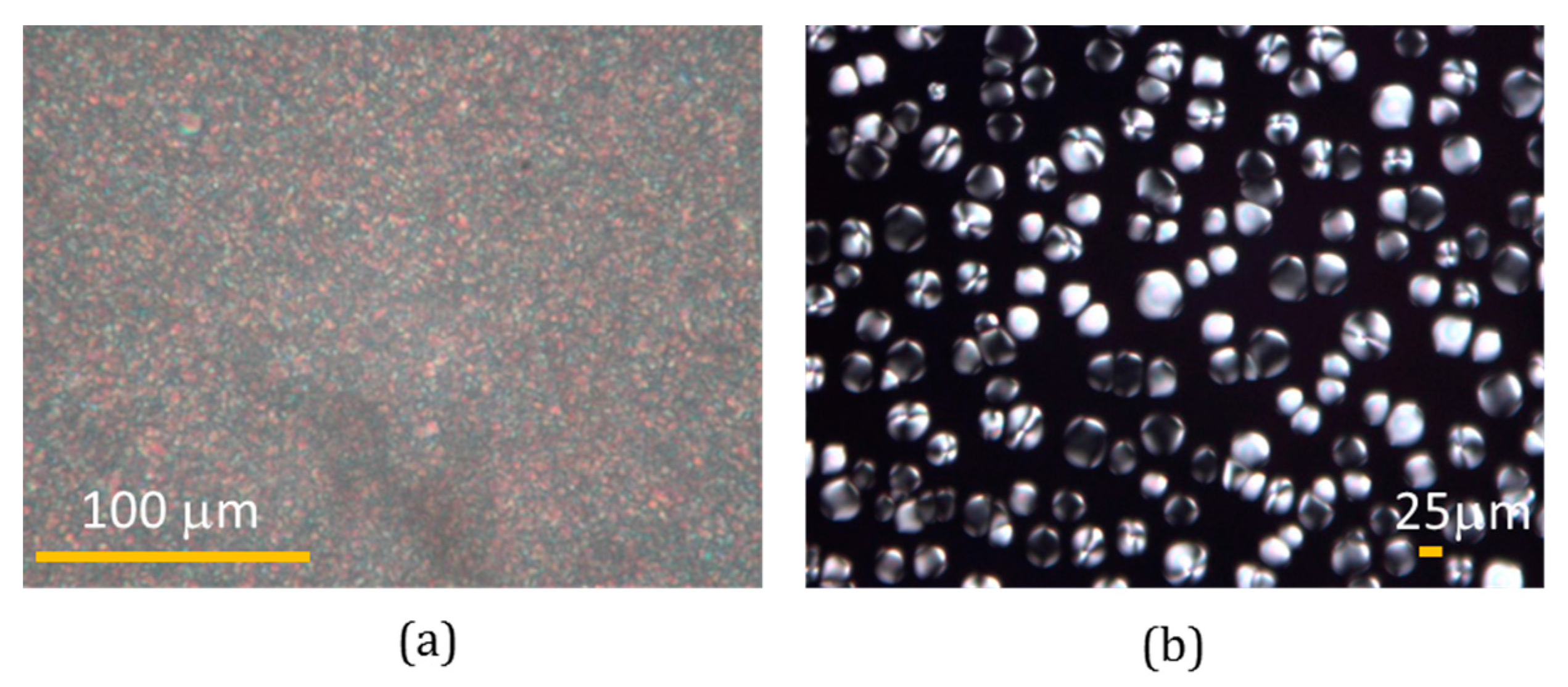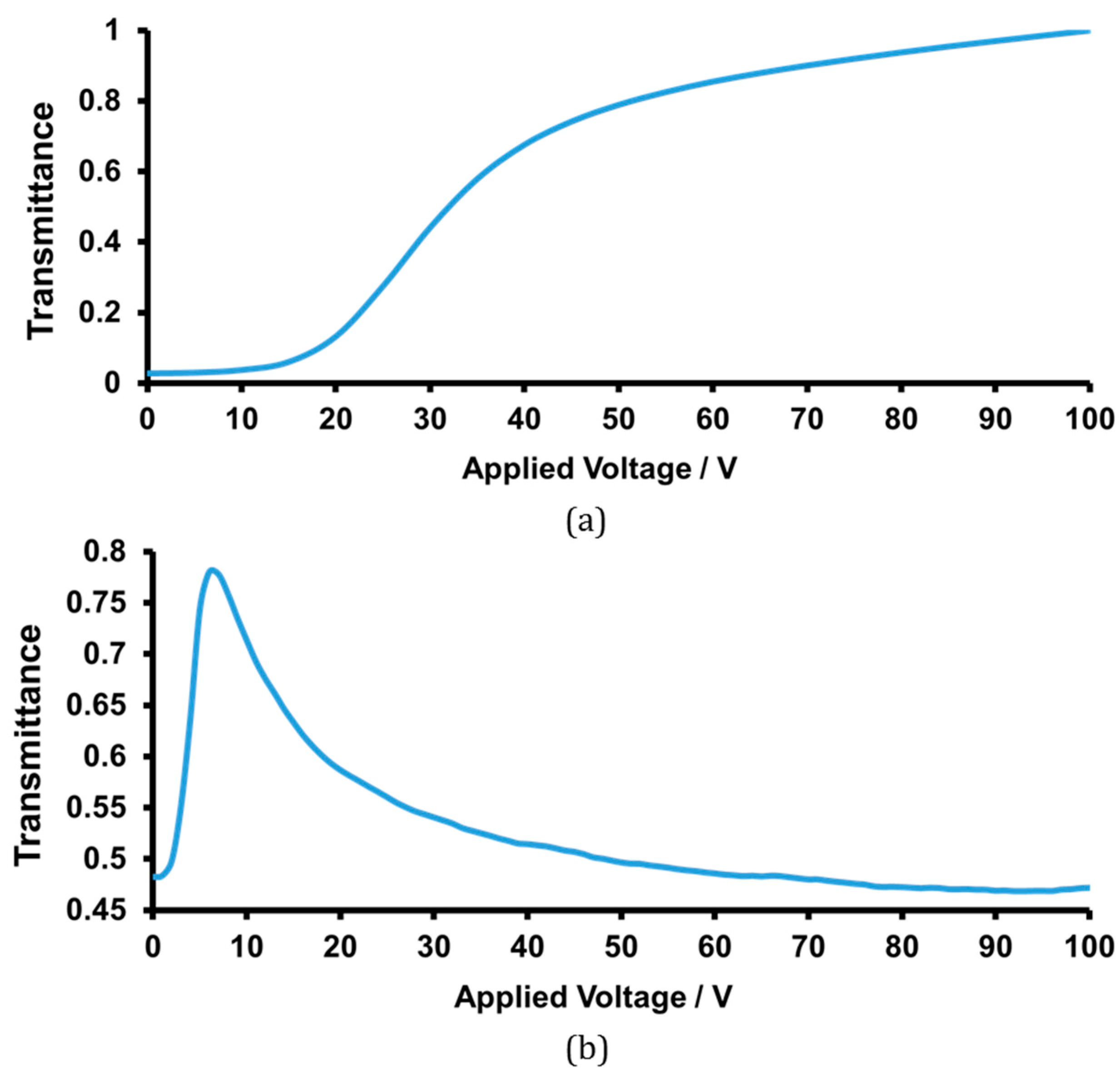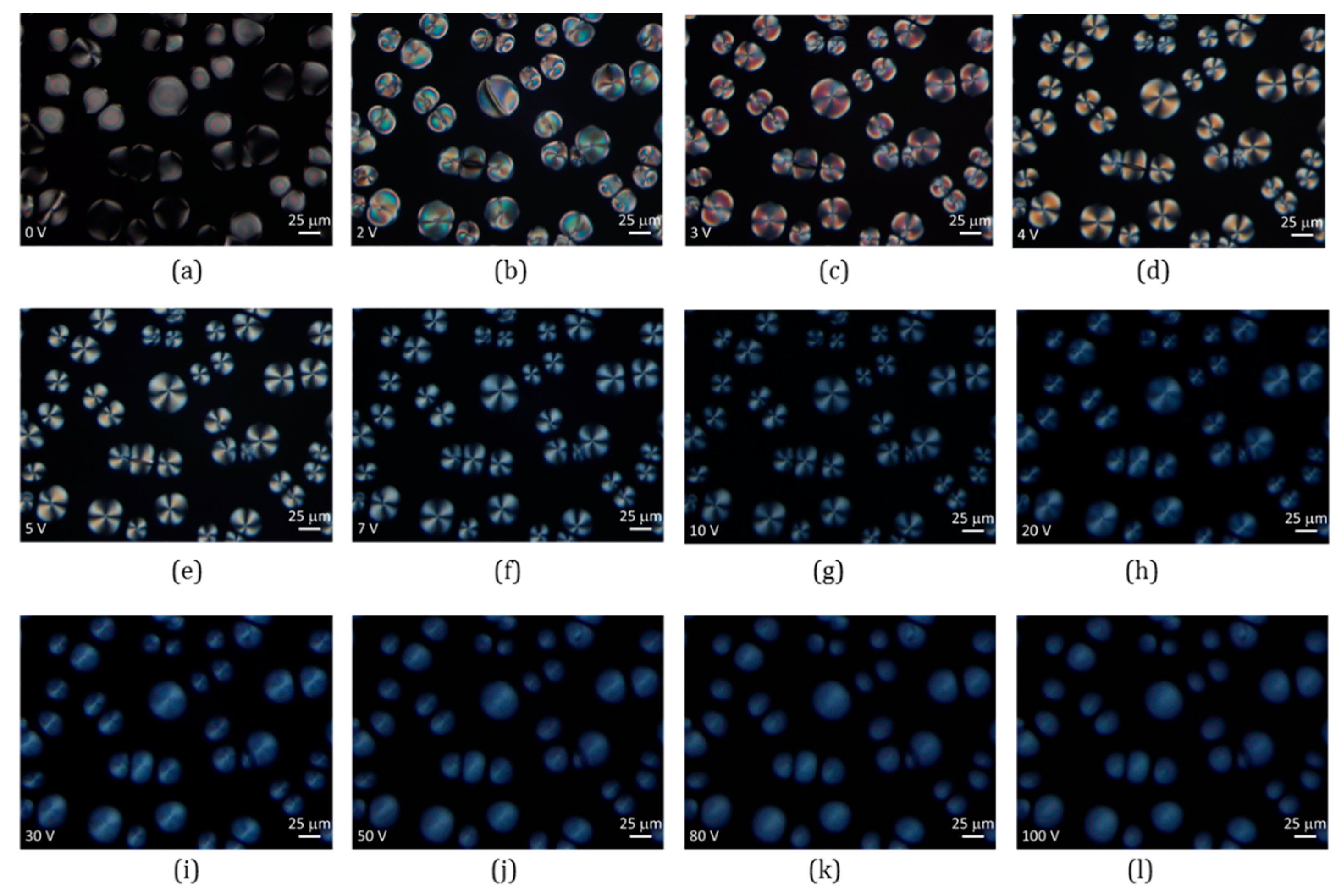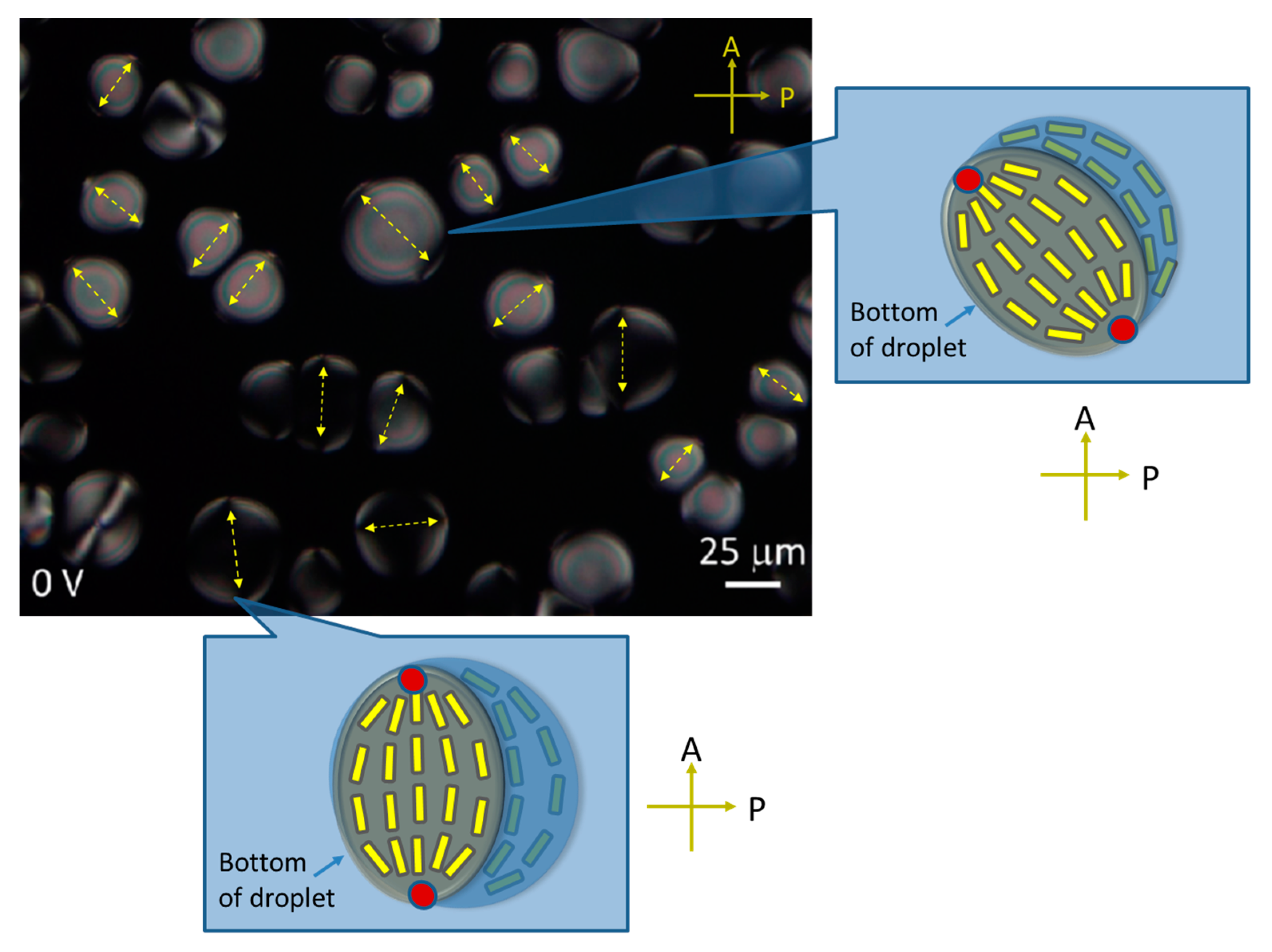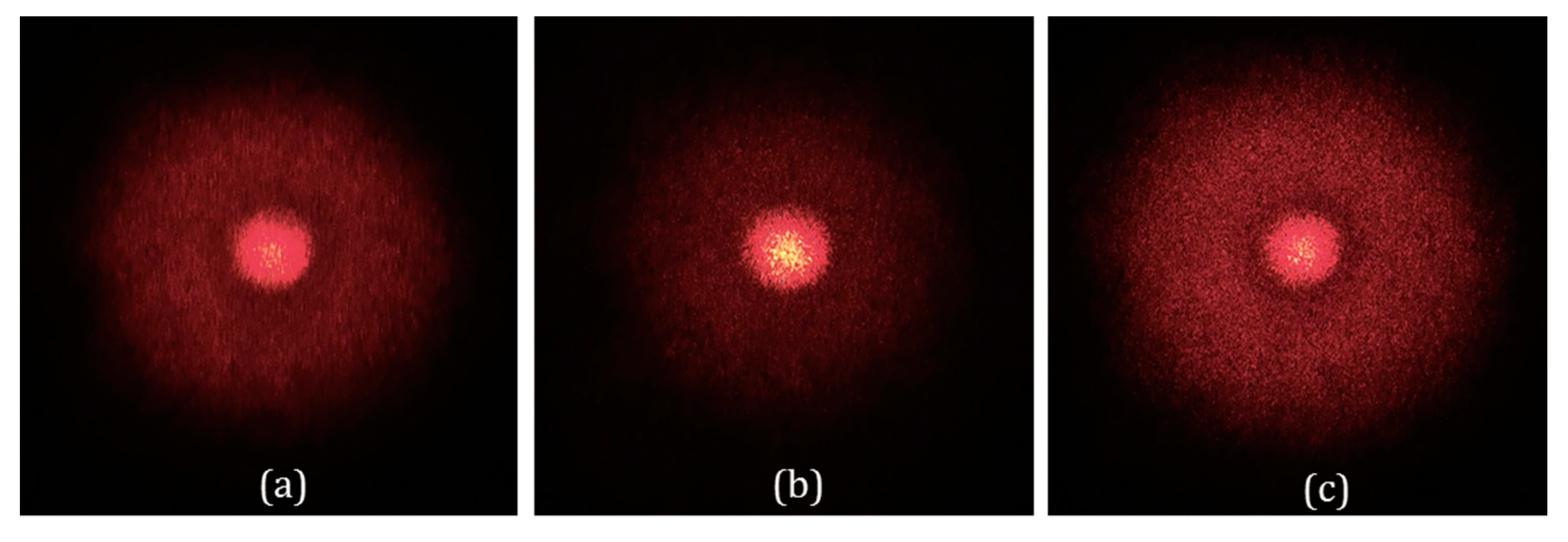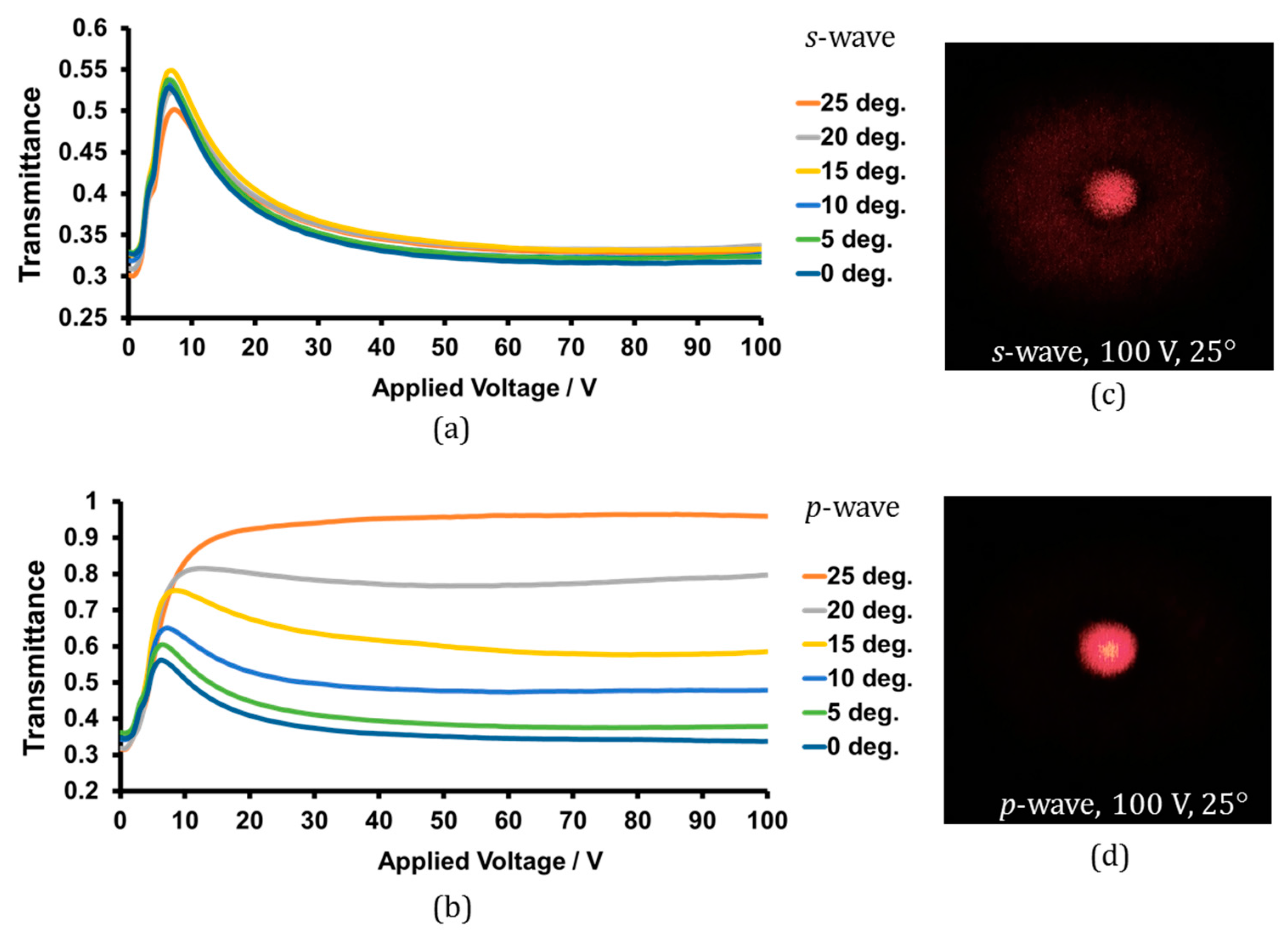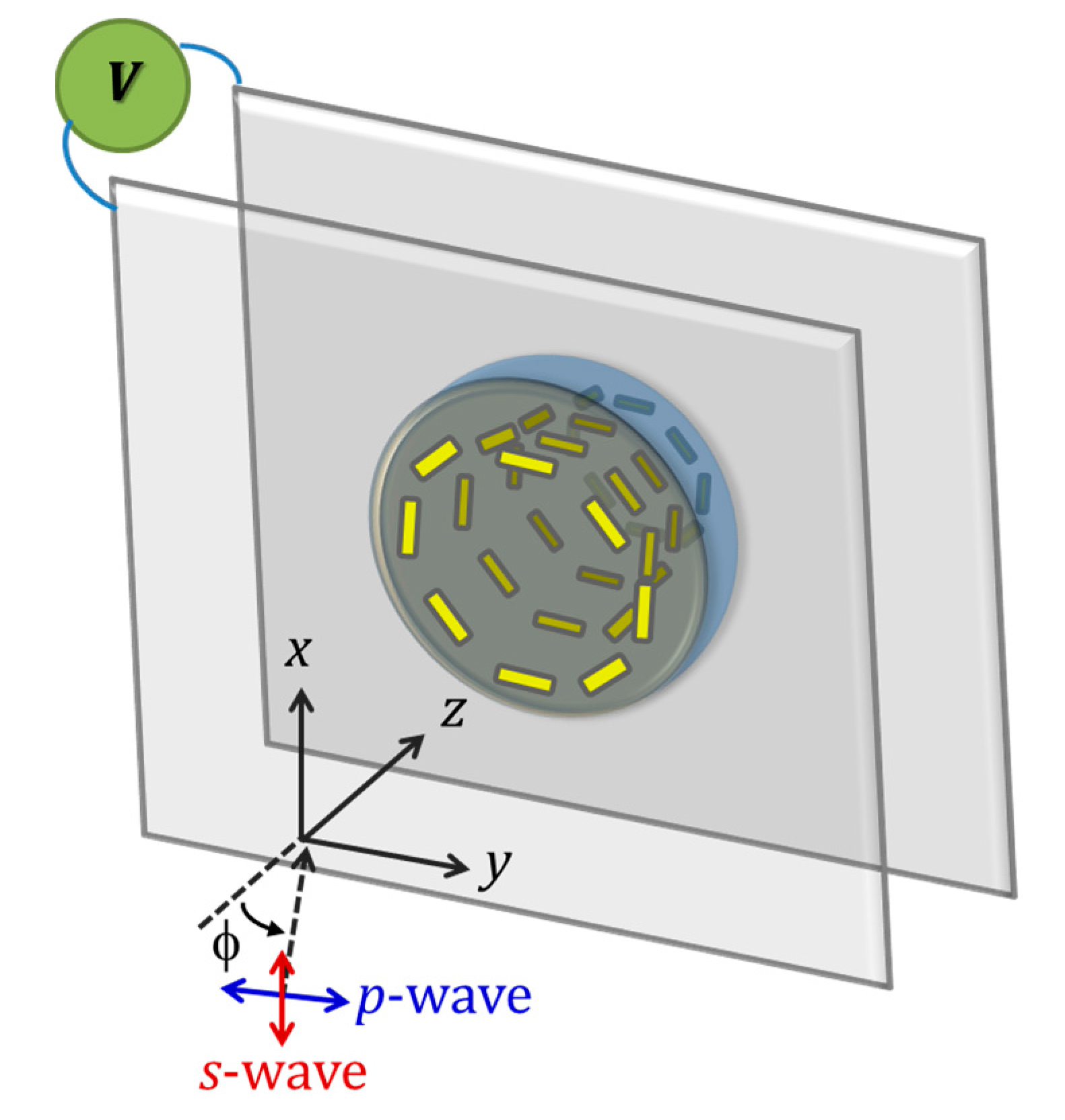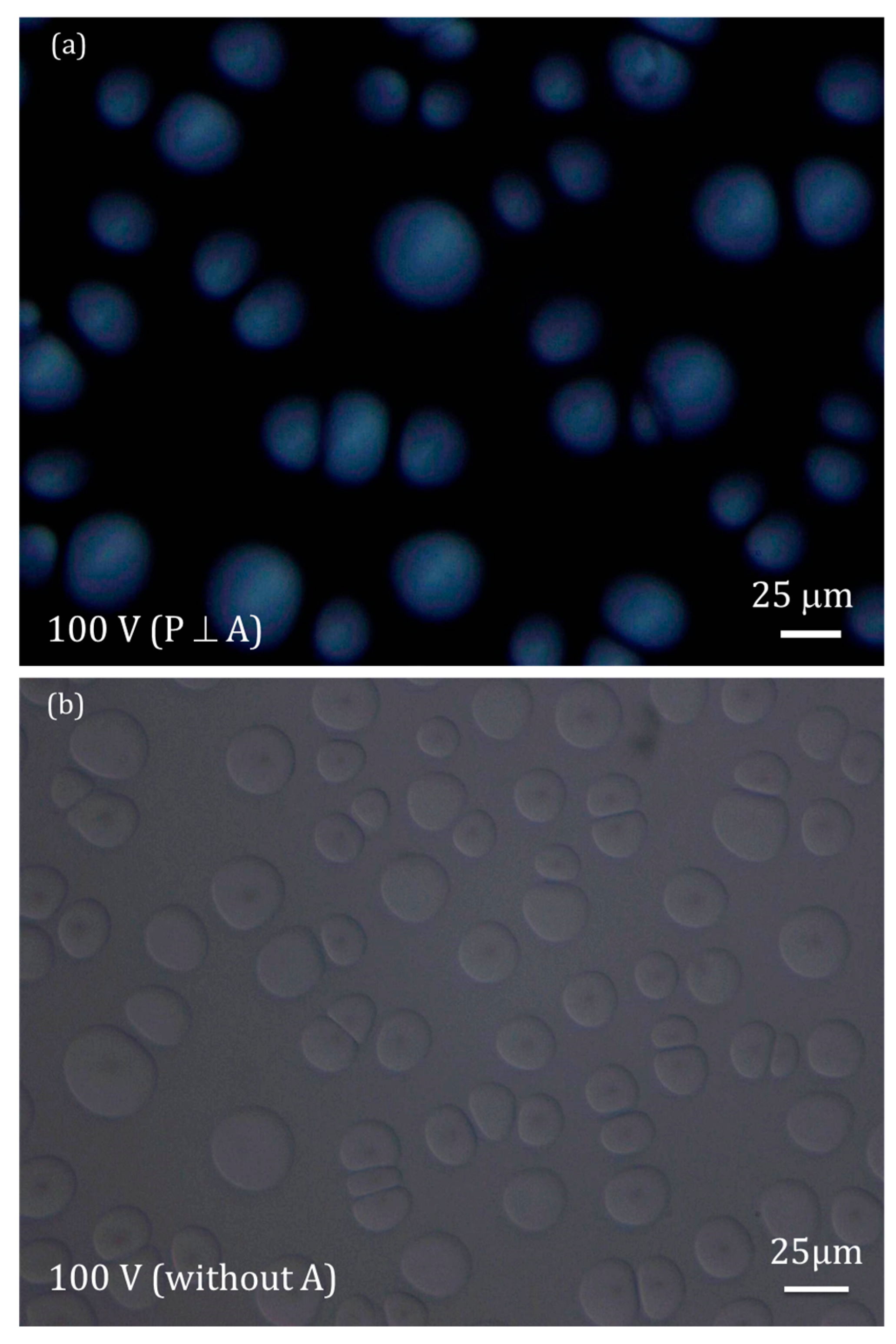3. Results and Discussion
Figure 1a shows the image of the formed PDLC film observed under POM with crossed polarizers after high-intensity exposure of UV light for 10 min. The LC droplets obtained by high-intensity exposure show a droplet distribution of high density and small size (sub micrometers) in the polymer matrix. The corresponding
T-V curve of the small-droplet PDLC film measured at normal incidence of the non-polarized probe beam is displayed in
Figure 2a. The transmittance of the sample increases from a very low value of off-state (~2%) to a very high value (~100%) of on-state with slowly increasing voltage to 100 V. A high contrast of transmission between on/off state can be achieved. The strong (less) scattering is induced from many interfaces between the LC droplets and the polymer matrix in which their refractive indices are strongly mismatched (matched) at 0 V (100 V) in an off- (on-) state. Such a typical EO feature in the traditional PDLC allows a wide range of applications, such as displays [
4].
Large LC droplets with sizes of 20–40 μm in the PDLC film can be obtained by the low-intensity UV exposure for 12 h, as displayed in
Figure 1b. The corresponding
T-V curve of the large-droplet PDLC film measured at normal incidence of the probe beam is displayed in
Figure 2b. The
T-V curve exhibits a concave-downward variation in the transmittance with increasing voltage from 0 V to 100 V. The transmittance initially increases from 48% at V = 0 V to nearly a maxima of 78% at 7 V and then decreases slowly to 47% at V = 100 V. The trend of the EO feature at voltages ranging lower than 7 V is similar to that shown in traditional PDLC. The droplet image observed under POM with crossed polarizers, as shown in
Figure 1b, shows bipolar LC configuration in droplets, thus reflecting homogeneous alignment of LCs by the polymer wall of droplets in the present PDLC. According to the information stated in Ref. [
11], the polymer wall features weak anchoring on LCs in droplets. In comparison with small-droplet PDLC systems, larger size of LC droplets in large-droplet PDLC can lead to weaker anchoring of LCs by the polymer wall in the middle of droplets, such that low threshold voltage (~1 V) and a sharp slope at 1 V to 7 V can be obtained. The weak scattering due to there being relatively few scattered droplets present in the PDLC can lead to relatively high transmittance at 0 V. At voltages ranging from 7 V to 100 V, the present PDLC exhibits an abnormal EO feature. The transmittance decreases from its maxima at voltages from 7 V to 100 V, and this result is never observed in the traditional PDLC systems. To explain the unpredictable abnormality of the large-droplet PDLC, we further observe its images at 0, 2, 3, 4, 5, 7, 10, 20, 30, 50, 80, and 100 V under POM with crossed polarizers, as shown in
Figure 3a−l, respectively. At V = 0 V, the droplet image shown in
Figure 3a displays that bipolar axes for most of droplets lie on the plane parallel to the substrates, implying that LCs in droplets experience a homogenous anchoring force parallel to the substrates. To identify the origin of this force, we examine the side-view SEM image of large-droplet PDLC after removing LCs. As shown in
Figure 4, each LC droplet features dome-like morphology with a bottom parallel to cell substrate after complete photopolymerization. The bottom of each droplet does not contact directly with the substrate because of the formation of a thin polymer film between them. This polymer layer may induce homogeneous anchoring force on LCs of each droplet. According to the above-mentioned information, we provide two examples of LC configuration for the dome-like bipolar droplets at V = 0 V, as displayed in
Figure 5, where yellow arrows and red points represent bipolar axes and two surface point defects in droplets, respectively. When the bipolar axis of a droplet lies at nearly ±45° and 0° (or 90°), the droplet will display a brighter and darker image under POM with crossed polarizers, respectively. This phenomenon occurs due to the large and small phase retardations for optical axes (along the bipolar axes) at ±45° and 0° (or 90°), resulting in strong and weak light leakages through the analyzer, respectively. This result is similar to the case when droplets are spherical with a bipolar axis lying on cell substrate surface. At voltages from 0 V to 7 V, the PDLC image shows a similar variation to that in traditional PDLC when the voltage increases. That is, the color of each bipolar droplet changes from 0 V to 4 V, and a crossed dark fringe gradually appears from 4 V to 7 V. The result is attributed to the gradual decrease of the phase retardation through each droplet as the bipolar axis of the droplet reorients gradually from a random orientation at 0 V to the direction of the applied electric field. When the voltage continues to increase from 7 V to 100 V, the appearance of each droplet becomes increasingly hazy, and the crossed dark fringe becomes unclear. Additionally,
Video S1 (in the
Supplementary File) presents the corresponding time-lapse photograph (one photo per second) for observing the variation in the PDLC image in time from 0 V to 100 V. The video shows that the LC droplets gradually become foggy. The LC structure in each droplet is more strongly disturbed with a high possibility when the voltage applied exceeds 7 V. This phenomenon reflects the abnormal decay of the transmission in the
T-V curve from 7 V to 100 V in the large-droplet PDLC film. In general, as the voltage applied increases, the bipolar axes of the LC droplets in a traditional PDLC (with small droplets) should be parallel to the applied field such that the crossed dark fringes become clearer as observed under the POM with crossed polarizers, resulting in a high transmittance. In contrast, the large-droplet PDLC presents the abovementioned strange EO behavior as the voltage exceeds 7 V. To investigate the physical mechanism that induces the foggy appearance of the droplets, which is associated with the abnormal EO behavior for the large-droplet PDLC, further analyses must be carried out. For examples, the transmitted patterns of the probe beam at normal incidence at specific voltages and the
T-V curves for
s- and
p-polarized incident probe beams (
s- and
p-waves, respectively) at oblique incidence should be compared. The following will show the associated experimental results.
To confirm that the decay of the transmittance of the large-droplet PDLC is associated with the foggy appearance of the droplets in the PDLC, we compare the transmitted patterns of the probe beam through the PDLC at some specific voltages.
Figure 6a–c show the patterns at 0, 7, and 100 V, respectively. The strong and weak scattering patterns at 0 and 7 V due to the mismatching and matching of refractive indices for the LC droplets and the polymer matrix, respectively, reflect the low and high transmittances of the PDLC shown in
Figure 2b. The strong scattering pattern at 100 V through the PDLC shown in
Figure 6c implies that the decay trend of the
T-V curve over 7 V is certainly associated with the foggy LC droplets at the high voltage regime (i.e., 7–100 V). Given that LC is a fluid that generally buries a specific amount of charged impurities after it is manufactured, it is not difficult to associate the mechanism for inducing such foggy LC droplets with the turbulence of the charged impurities under the application of an external voltage; that is, with the EHD effect in the droplets. To further study the property of the EHD turbulence in the large droplets at the high voltage regime, we measure the
T-V curves for
s- and
p-waves at various angles of incidence (φ) and examine the side-view SEM morphology of the large-droplet PDLC film.
Figure 7a,b shows the
T-V curves for
s- and
p-waves, respectively, at φ = 0°−25°. The variation in the
T-V curve for
s-wave is fixed as φ increases from 0° to 25°, and the transmittance at 25° slightly decays due to the Fresnel reflections at the interfaces between the cell and air. However, the
T-V curves for
p-wave show that the degree for the decay of the transmittance at the high voltage regime gradually reduces from φ = 0° to φ = 20°. From φ = 20° to φ = 25°, the transmittance does not decay further and even continues to increase with rising voltage.
Figure 7c,d shows the transmitted patterns of
s- and
p-waves through the PDLC, respectively, at 25°. The scattering is strong for
s-wave but not for
p-wave; this result is consistent with the
T-V curve displayed in
Figure 7a,b. The experimental results in
Figure 7 show strong polarization independence and polarization dependence in the
T-V curve and in the scattering strength at the high voltage regime at normal and oblique incidence, respectively. These findings imply that the EHD turbulence does not flow isotropically.
After summarizing the abovementioned experimental results and associated analyses, we first establish a physical model for describing the EHD turbulence in the large LC droplets of the present PDLC. As shown in
Figure 8, a vortex-like LC director field can be induced by a vortex-like turbulence of charged impurity whose circular flowing is along the azimuthal direction projected on the
xy plane, and the axis of rotation is roughly along the
z direction. The vortex-like turbulence of charged impurity is generated by the EHD effect under the action of the electric field along the
z axis and the confinement of the dome-like boundary of the droplets whose bottoms are parallel to the cell substrates (
Figure 4).
In considering the physical model of the vortex-like LC director field, two factors can induce the polarization independence and polarization dependence for the
T-V curves and the scattering for normal and oblique incidences, respectively, at the high voltage regime. One is scattering due to mismatch of the refractive indices at the interfaces between the LC droplets and the polymer (
nLC and
np, respectively). Another is dynamic scattering due to the local fluctuation of the director field within the droplet when the light propagates through the large LC domain (20−40 μm) in each dome-like droplet. The foggy appearance of each LC droplet is strong evidence to support the latter factor. However, given the stabilization of the electric field along the
z axis, the component of the vortex-like director field projected on the
xy plane can more apparently fluctuate locally than that on the
z axis under the influence of the vortex-like turbulence of charged impurity in each droplet. Suppose φ is defined as the incident angle of the probe beam relative to +
z direction on the
yz plane, which is the plane of incidence in the model schema shown in
Figure 8. At φ = 0 (along the +
z direction), the incident wave with a linear polarization along the
x or
y directions will experience an identically large mismatch of
nLC and
np concomitantly with a strong local fluctuation of the director field projected on the
xy plane because the incident polarization is on the
xy plane, resulting in strong resultant scattering and low transmittance at the high voltage regime. As φ increases, both the mismatch of
nLC and
np and the local fluctuation of the vortex-like director field for the
s-wave (along the
x direction) are unchanged, because the polarization of the
s-wave is still on the
xy plane. However, both factors decrease for
p-wave under increasing φ because the polarization of the
p-wave deviates from being on the
xy plane. Thus, a strong and low resultant scattering can be induced, causing low and high transmittance for
s- and
p-waves, respectively, at high voltage regimes such as, for example, 25°.
We unintentionally observe a greenery concentric circle system for each droplet under the POM with crossed polarizers. As shown in the PDLC image displayed in
Figure 9, which is the magnified version of
Figure 3l, greenery concentric circles appear on each LC droplet. These concentric circles are not very clear probably due to the strong scattering of each LC droplet. Given the azimuthally symmetric vortex-like director field in the dome-like LC droplet, the effective phase retardation of the incident light (green component) through each LC droplet in the POM periodically changes along the depth of the LC droplets, resulting in the greenery concentric circle system in each droplet. Additionally,
Video S2 (in the
Supplementary File) presents the corresponding time-lapse photograph (one photo per second) for observing the variation in the greenery concentric circle system in time at 100 V for 20 s. The greenery concentric circles circulate on the
xy plane along the rotational axis normal to the
xy plane. This result implies the existence of the vortex of charged impurity in the droplet, which can induce the local fluctuation of the vortex-like director field on the
xy plane and lead to the dynamic circulation of the greenery concentric circles. Another piece of direct evidence for the existence of the vortex-like turbulence of the charged impurity at the high voltage regime is the formation of defect lines at the centers of the droplets of the PDLC film.
Figure 9b presents the POM image without the analyzer at 100 V, in which most droplets appear as dark dots on their centers. These dots indicate the position of the rotational axis, and thus the defect line for the vortex-like director field.
Videos S3 and S4 (in the
Supplementary File) show the corresponding time-lapse photographs (one photo per second) for observing the variations in the PDLC image at voltages from 0 V to 100 V and in the dark-dot pattern of the droplets in time at 100 V for 20 s, respectively, under the POM without analyzer. The former video shows that the dark dot and corresponding defect line nearly at the central region of the droplet form at the high voltage regime, and the bipolar defects of the droplets simultaneously disappear. The latter video shows that the pattern of the dark dots at the central regions of the droplets slightly fluctuates with time. This result is reasonable, because the defect line is dynamic enclosed by the dynamic vortex-like turbulence of charged impurity in each droplet.
As presented in the previous experimental results, anomalous EO characteristics can only occur in large-droplet PDLC systems but not in small-droplet ones. To determine how the size of LC droplets influences abnormal EO feature of PDLC, we carry out additional experiments by preparing six PDLC cells with different droplet sizes obtained after UV curing at intensities of 6.61, 5.74, 4.33, 1.53, 0.92, and 0.83 mW/cm
2 for the same time of 12 h. Except for UV intensity, all experimental conditions used in this experiment are the same with those used to fabricate large-droplet PDLC introduced in
Section 2.
Figures S1–S6 (in the
Supplementary File) present recorded POM images of PDLC (with crossed polarizers) obtained after UV curing at intensities of 6.61, 5.74, 4.33, 1.53, 0.92, and 0.83 mW/cm
2 at V = 0–100 V, respectively. Notably, POM images for the six PDLC films show that the average size of LC droplets in formed PDLC films increases from around 5 μm to around 25 μm with decreasing curing intensity of UV light from 6.61 mW/cm
2 to 0.83 mW/cm
2. Corresponding
T-V curves of incident non-polarized probe beam at normal incidence for the six PDLC cells in
Figure 10 show less difference among PDLC cells in terms of EO behavior at low-voltage regime. This result is consistent with the revolution of recorded POM images for the six PDLC films at a low-voltage regime (
Figures S1–S6). However, at high-voltage regimes (e.g., at 100 V), larger droplet size causes the appearance of foggier droplets under POM with crossed polarizers. Thus, these results provide evidence that the effect of EHD-induced vortex-like director field will become weaker as droplets in PDLC become smaller. Experimental results support the notion that abnormal EO of PDLC becomes more notable when droplets of PDLC are larger at high-voltage regime; that is, decay for transmittance in the
T-V curve becomes more serious when LC droplets of PDLC become larger (
Figure 10). These results evidently imply that formation of EHD-induced vortex-like turbulence of charged impurities is significantly related to droplet size of PDLC. Notably, the
T-V curves in
Figure 10 shows that the transmittance no longer decays at the high-voltage regime once the intensity of UV irradiation to form the PDLC is as high as 4.33 mW/cm
2. For the present PDLC system, thresholds of average droplet size in PDLC for inducing abnormal EO feature measures around 10 μm (
Figure S3).
Although the experimental results mentioned above support the possible occurrence of the addressed vortex model of LC director field on the x-y plane, the presence of an actual director field may be more complex, and the LC director probably lies in the z direction in the middle of droplets under the action of an applied electric field, except near surfaces. To further understand the system and its mechanism, additional experiments should consider specific influencing factors, such as droplet shape and frequency of external AC voltage. Associated simulation work will be carried out in the future.
